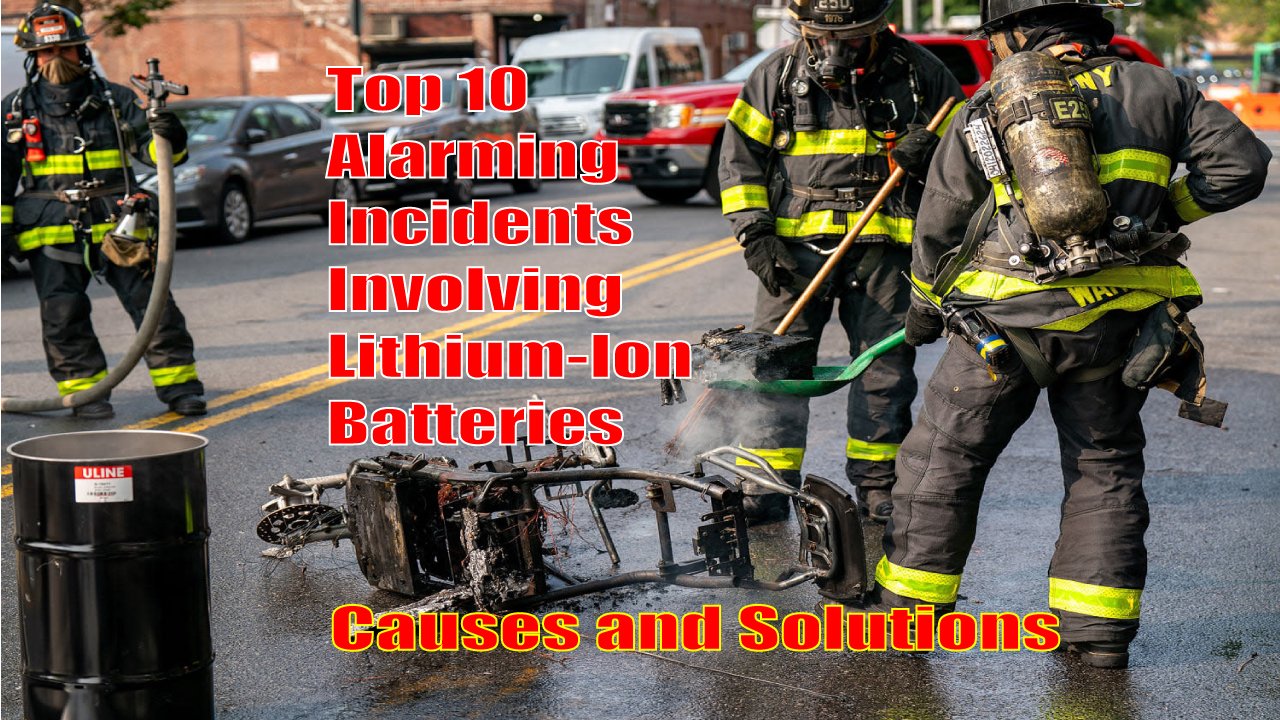Introduction:
Lithium-ion batteries, often referred to as Li-ion batteries, have become an indispensable part of our modern world. These rechargeable energy storage devices have revolutionized the way we power our portable electronics, electric vehicles, and even homes. In this article, we will delve into the world of lithium-ion batteries, exploring their key components, working principles, applications, and the latest advancements in this ever-evolving technology. Whether you’re a tech enthusiast or simply curious about the batteries that power your daily life, this comprehensive guide will shed light on the fascinating world of lithium-ion batteries.
Table of Contents
Incidents Issues
Alarming incidents involving lithium-ion batteries have garnered significant attention in recent years, raising concerns and shedding light on the potential dangers associated with these widely used power sources. These incidents encompass a range of issues, including overheating, fires, and even explosions, linked to lithium-ion battery technology. Such events have gained notoriety due to the sheer ubiquity of these batteries in our everyday lives, from smartphones and laptops to electric vehicles and portable power banks.
The primary concern lies in the inherent characteristics of lithium-ion batteries, which, while highly efficient and compact, can pose risks under certain conditions. These risks are primarily associated with the chemistry of the batteries, which rely on lithium and a variety of volatile compounds to store and release energy. When subjected to overcharging, punctures, exposure to extreme temperatures, or manufacturing defects, lithium-ion batteries can become unstable, leading to thermal runaway—a chain reaction of chemical and physical processes that generate heat and potentially result in a fire or explosion.

The potential dangers are multifaceted. First and foremost, fires or explosions involving lithium-ion batteries can cause significant property damage and pose a severe risk to personal safety. In the case of electric vehicles, for example, a battery-related fire can be extremely challenging to extinguish and may even lead to a risk of chemical contamination, further complicating firefighting efforts. Additionally, these incidents can result in environmental hazards as hazardous materials are released into the surroundings.
Furthermore, the economic impact of such incidents, including product recalls and legal liabilities for manufacturers, can be substantial. The consumer electronics and automotive industries, which heavily rely on lithium-ion battery technology, face ongoing challenges in ensuring the safe use of these power sources.
In light of these concerns, it is crucial to understand the factors that contribute to the risks associated with lithium-ion batteries and the measures taken to mitigate these dangers. Advances in battery safety technology, stringent manufacturing standards, and ongoing research are all aimed at making lithium-ion batteries safer and more reliable for the ever-expanding range of applications they serve.
10 Causes of Alarming Incidents:
1. Chemical Composition:
Lithium-ion batteries contain a flammable and reactive electrolyte, typically a lithium salt dissolved in a solvent. If the battery is punctured, overcharged, or exposed to extreme conditions, it can lead to a chemical reaction that generates heat, causing the battery to swell, rupture, or catch fire.
2. Overheating and Overcharging:
Overcharging a Li-ion battery can lead to excessive heat generation. Many mobile devices are designed to prevent overcharging, but substandard chargers may not have these protections. Overheating, whether from overcharging or excessive use, can weaken the battery and increase the risk of thermal runaway.
3. Manufacturing Defects:
Li-ion batteries are sensitive to manufacturing defects, which can lead to internal short circuits, electrical imbalances, and other issues. Inadequate quality control during the manufacturing process can result in subpar batteries with increased risks of failure.
4. Counterfeit and Substandard Components:
The use of counterfeit or substandard batteries, chargers, and other components in the market is a significant concern. These low-quality components may not adhere to safety standards and can pose higher risks of failure and thermal issues.
5. Physical Damage:
Physical damage to the battery, such as punctures, bending, or crushing, can compromise the battery’s structural integrity and safety. Even minor damage can lead to internal shorts and heat buildup.
6. Extreme Environmental Conditions:
Extreme temperatures, humidity, and pressure changes can stress Li-ion batteries and make them more prone to failure. For example, leaving a device in a hot car during summer can accelerate the degradation of the battery.
7. Aging and Wear and Tear:
Over time, Li-ion batteries degrade due to chemical processes within the cells. This degradation can make the battery less stable and more prone to overheating or sudden failure.
8. Software and Firmware Issues:
Software or firmware glitches in the device’s battery management system can mismanage charging and discharging, leading to excessive heat generation and potential thermal issues.
9. Fast-Charging Technologies:
While fast-charging technologies are convenient, they can generate more heat during the charging process. If not managed properly, this increased heat can affect the battery’s lifespan and safety.
10. Safety Regulations and Enforcement:
In some cases, lax safety regulations and enforcement can lead to substandard batteries and chargers entering the market without adequate testing and quality control.
Recent Alarming involving lithium-ion batteries on airplane: More than 60 incidents occur every week.


Ref. NBC News:
5 real-world incidents involving lithium-ion batteries
1. Samsung Galaxy Note 7 Recall (2016):
One of the most widely publicized incidents involved the Samsung Galaxy Note 7 smartphones. Reports of these devices catching fire due to faulty lithium-ion batteries prompted a massive recall, costing the company billions of dollars. The incidents led to aviation authorities banning the use of these phones on flights, highlighting the severe safety concerns associated with lithium-ion batteries in portable electronics.

Ref. BBC News
2. Boeing 787 Dreamliner (2013):
The Boeing 787 Dreamliner aircraft faced battery-related issues when lithium-ion batteries in the plane’s electrical systems overheated and, in some cases, caused fires. This led to the grounding of the entire Dreamliner fleet for a period, demonstrating the potential safety risks in aviation.

Ref. Wikipedia
3. Electric Vehicle Fires:
Electric vehicle (EV) fires involving lithium-ion batteries have raised concerns about safety. High-profile cases, such as Tesla Model S fires, have occurred after accidents and battery damage. The high energy density of lithium-ion batteries can make extinguishing such fires challenging, and there have been ongoing efforts to develop safer battery chemistries and fire suppression systems for EVs.

4. Hoverboard Fires (Multiple Incidents):
Hoverboards, popular self-balancing scooters, experienced a series of fires and safety concerns related to their lithium-ion batteries. Numerous reports emerged of hoverboards catching fire while charging or in use, prompting recalls and safety warnings in various countries.
5. E-cigarette Explosions:
Lithium-ion batteries used in e-cigarettes have occasionally exploded or caught fire, causing injuries and property damage. These incidents have raised awareness about the importance of safe battery handling and the potential risks associated with consumer products powered by these batteries.
10 Safety Measures and Precautions:
1. Use Original or High-Quality Chargers:
Always use the original charger provided by the device manufacturer or reputable third-party chargers that meet safety standards. Cheap or knockoff chargers may not have adequate safety features.
2. Avoid Overcharging:
Unplug your device once it reaches a full charge. Overcharging can generate excess heat and stress the battery, potentially leading to safety issues. Many modern devices have mechanisms to prevent overcharging, but it’s still a good practice to unplug them.
3. Store and Charge in Moderate Temperatures:
Extreme temperatures, both hot and cold, can be harmful to lithium-ion batteries. Avoid charging your devices in direct sunlight, in freezing conditions, or in excessively hot environments. Store devices in a cool, dry place.
4. Use a Surge Protector:
Plug your chargers into surge protectors to safeguard against power surges that could damage your devices and batteries.
5. Replace Damaged Cables and Chargers:
If you notice frayed or damaged charging cables or chargers, replace them immediately. Damaged cables can expose wires and pose an electrical or fire hazard.
6. Keep an Eye on Battery Health:
Some devices have built-in battery health monitoring features. Check your device settings for battery health information and replace the battery if it shows signs of degradation.
7. Don’t Crush or Puncture Batteries:
Avoid applying physical force to lithium-ion batteries. Do not puncture or crush them, as this can lead to internal damage and potential hazards.
8. Recognize Warning Signs:
Be vigilant for warning signs such as a swollen or bulging battery, excessive heat during charging, unusual odors, or a device that becomes unusually hot during use. If you notice any of these signs, stop using the device and seek professional help.
9. Unplug Devices During Unattended Charging:
Avoid leaving your devices to charge unattended for extended periods, especially overnight. Unplug them once they are fully charged to reduce the risk of overcharging incidents.
10. Follow Manufacturer’s Guidelines:
Always adhere to the manufacturer’s recommendations and guidelines for charging and using their devices. They design their products with safety in mind, so following their instructions is crucial.
By following these precautions and being aware of the potential risks associated with lithium-ion batteries, you can significantly reduce the likelihood of incidents and ensure the safe and proper use of your electronic devices. Remember that safety should always be a top priority when dealing with battery-powered technology.

10 respond quickly and effectively is crucial
1. Safety First:
Prioritize your safety and the safety of others. If you notice signs of an alarming incident, such as smoke, unusual heat, or a strange odor, take immediate action to protect yourself and those around you.

2. Disconnect and Power Down:
If the alarming incident involves a device that is still connected to a power source, unplug it or disconnect the power source if it’s safe to do so. In the case of a vehicle or an electric appliance, turn off the power.
3. Evacuate if Necessary:
If the situation escalates, and you cannot quickly contain the incident, evacuate the area. Ensure that everyone is safely out of harm’s way and call emergency services if required.
4. Do Not Use Water:
Avoid using water to extinguish a lithium-ion battery fire. Unlike conventional fires, water can exacerbate the situation by causing chemical reactions and potentially leading to more significant hazards. Use appropriate fire extinguishers (Class D for metal fires) if available.
5. Contain and Isolate:
If it is safe to do so, move the device or battery to a non-flammable surface or container. Ensure that it cannot spread to other materials or objects that could catch fire.
6. Call Emergency Services:
If the incident is serious or cannot be contained, call emergency services immediately. Provide them with accurate information about the situation and location.
7. Use Fire Extinguishers:
If you have access to a Class D fire extinguisher designed for metal fires, and you are trained to use it, you can attempt to extinguish the fire. However, exercise extreme caution and prioritize personal safety.
8. Do Not Attempt to Disassemble or Cool the Battery:
Do not try to open, disassemble, or cool a lithium-ion battery yourself. Leave these tasks to professionals who are trained to handle such incidents safely.
9. Stay Informed:
Keep an eye on the situation and stay informed about the status of the incident. Emergency responders will assess the situation and determine whether it’s safe for you to re-enter the area.
10. Dispose of Damaged Batteries Safely:
If the battery has been involved in an alarming incident, do not use it again. Properly dispose of it according to local hazardous waste regulations.
Regulations and Industry Standards:
Ongoing research and innovations in battery technology are at the forefront of enhancing safety and reliability in various applications, including mobile devices, electric vehicles, and renewable energy storage. Two significant advancements in this field are solid-state batteries and advanced thermal management systems.
1. Solid-State Batteries:
Solid-state batteries represent a promising breakthrough in battery technology. Unlike traditional lithium-ion batteries, which use liquid electrolytes, solid-state batteries employ solid electrolytes, offering several advantages for safety and performance:
- Enhanced Safety: Solid-state batteries are inherently safer than their liquid electrolyte counterparts. They are less prone to leakage, thermal runaway, and the risks of combustion associated with flammable liquids in traditional lithium-ion batteries.
- Higher Energy Density: Solid-state batteries can achieve higher energy densities, which means they can store more energy in the same volume. This makes them attractive for electric vehicles, as it can extend their range.
- Longer Cycle Life: Solid-state batteries tend to have a longer cycle life, which means they can be charged and discharged more times without significant degradation. This contributes to their overall durability and lifespan.
- Improved Temperature Tolerance: Solid-state batteries can operate efficiently across a wider temperature range compared to liquid electrolyte batteries, making them suitable for extreme conditions.
- Faster Charging: Solid-state batteries are often capable of faster charging, reducing the time required to charge a device or vehicle.
Researchers and companies are actively working on addressing the challenges associated with the commercialization of solid-state batteries, such as manufacturing scalability and cost-effectiveness. The automotive industry, in particular, is exploring solid-state battery technology to enhance the safety and performance of electric vehicles.
2. Advanced Thermal Management Systems:
Advanced thermal management systems are designed to control and dissipate heat more effectively within battery packs. These systems are essential for preventing overheating and thermal runaway, which can lead to battery fires and other dangerous incidents. Some key advancements in thermal management include:
- Phase Change Materials (PCMs): PCMs are materials that can absorb and release heat during phase transitions (e.g., from solid to liquid). They are integrated into battery packs to regulate temperature. When the battery heats up, the PCM absorbs the heat, preventing overheating.
- Active Cooling Systems: Advanced cooling systems use liquid coolants or air to maintain the optimal operating temperature of battery cells. These systems are often found in electric vehicles to manage the thermal load during rapid charging and high-demand situations.
- Thermally Conductive Materials: The use of thermally conductive materials within the battery pack, such as graphite-based heat spreaders, can help distribute heat more evenly and efficiently, reducing hotspots.
- Sensors and Control Systems: Battery packs are equipped with sensors and control systems that monitor temperature and adjust cooling mechanisms accordingly, ensuring that the battery remains within a safe temperature range.
Advanced thermal management systems are crucial for improving the safety and longevity of batteries in high-demand applications, including electric vehicles and grid energy storage.
These innovations in battery technology, such as solid-state batteries and advanced thermal management systems, are contributing to a safer and more reliable energy storage landscape. As research and development continue, we can expect further advancements in battery safety and performance, paving the way for cleaner and more sustainable energy solutions.
Conclusion:
In conclusion, the ongoing research and innovations in battery technology are ushering in a new era of safety and reliability for a wide range of applications, from portable electronic devices to electric vehicles and renewable energy storage. The development of solid-state batteries and advanced thermal management systems represents significant milestones in this journey towards safer and more efficient energy storage solutions.
Solid-state batteries, with their solid electrolytes, offer enhanced safety, higher energy density, longer cycle life, improved temperature tolerance, and faster charging capabilities. These features make them particularly appealing for electric vehicles and various other applications where safety and performance are paramount. While challenges related to manufacturing scalability and cost-effectiveness remain, ongoing research and development are steadily addressing these hurdles.
Advanced thermal management systems are equally critical in maintaining the safety and reliability of batteries. Through phase change materials, active cooling systems, thermally conductive materials, and sophisticated control mechanisms, these systems help regulate temperature within battery packs, preventing overheating and thermal runaway. As a result, they contribute to extended battery lifespans and safer operation, especially in demanding environments like electric vehicles and grid energy storage.
This related more details visit


Leave A Comment